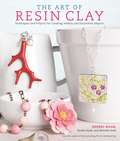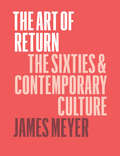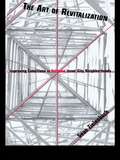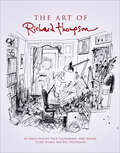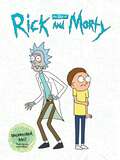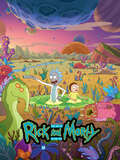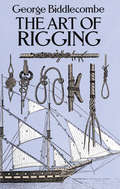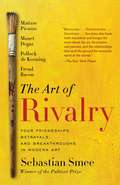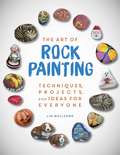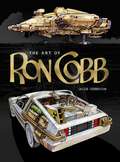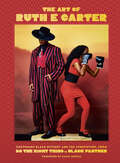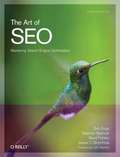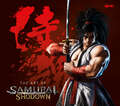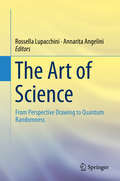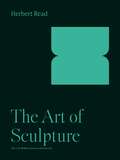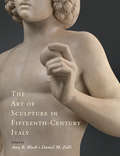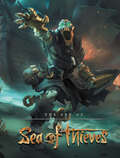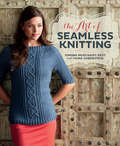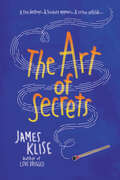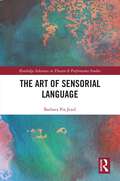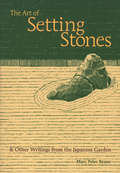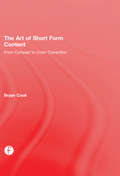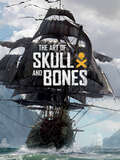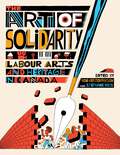- Table View
- List View
The Art of Resin Clay: Techniques and Projects for Creating Jewelry and Decorative Objects
by Rachel Haab Sherri Haab Michelle HaabDiscover the Creative Possibilities of Resin Clay Imagine being able to imitate the look of rare coral, create oversized but featherweight statement jewelry, or mix clay with other mediums--all without firing. The Art of Resin Clay explores the creative potential of this material, in both air-dry and two-part formulas, and guides you through everything you'll need to get started: * Information on choosing the right kind of resin clay, essential tools and techniques, and safety guidelines* Tips for mixing colors, finishing, and adding jewelry findings* 20 projects covering a variety of creative techniques * Galleries of work by influential artists and crafts designers who use this versatile materialFrom the Trade Paperback edition.
The Art of Return: The Sixties and Contemporary Culture
by James MeyerMore than any other decade, the sixties capture our collective cultural imagination. And while many Americans can immediately imagine the sound of Martin Luther King Jr. declaring “I have a dream!” or envision hippies placing flowers in gun barrels, the revolutionary sixties resonates around the world: China’s communist government inaugurated a new cultural era, African nations won independence from colonial rule, and students across Europe took to the streets, calling for an end to capitalism, imperialism, and the Vietnam War. In this innovative work, James Meyer turns to art criticism, theory, memoir, and fiction to examine the fascination with the long sixties and contemporary expressions of these cultural memories across the globe. Meyer draws on a diverse range of cultural objects that reimagine this revolutionary era stretching from the 1950s to the 1970s, including reenactments of civil rights, antiwar, and feminist marches, paintings, sculptures, photographs, novels, and films. Many of these works were created by artists and writers born during the long Sixties who were driven to understand a monumental era that they missed. These cases show us that the past becomes significant only in relation to our present, and our remembered history never perfectly replicates time past. This, Meyer argues, is precisely what makes our contemporary attachment to the past so important: it provides us a critical opportunity to examine our own relationship to history, memory, and nostalgia.
The Art of Revitalization: Improving Conditions in Distressed Inner-City Neighborhoods (Contemporary Urban Affairs #Vol. 12)
by Sean ZielenbachThis book discusses the revitalization of decayed inner-city neighborhoods. It explores the role of social capital in stabilizing and turning around distressed communities, and it highlights the roles that local actors can and do play in the revitalization process.The Art of Revitalization takes two Chicago neighborhoods, Englewood and North Lawndale, as case studies. Zielenbach discusses them in the context of racial change and urban decay in Chicago since World War II. The account of the changing neighborhoods is fascinating and clear, and the strength of the author's portrayal of Chicago's transformation sets the stage for his detailed analysis.
The Art of Richard Thompson
by Chris Sparks Bill Watterson David Apatoff Nick Galifianakis Mike RhodeA tribute to the cartoonist known as “Michelangelo with a sense of humor,” the creator of the beloved comic strip Cul de Sac (Pat Oliphant, editorial cartoonist).Richard Thompson is renowned among cartoonists as an “artist’s” cartoonist. Little known to all but those close to him is the extent of his art talent. This is the book that will enlighten the rest of us and delight us with the sheer beauty of his work.Divided into six sections, each beginning with an introductory conversation between Thompson and six well-known peers, including Bill Watterson, the book will present Thompson’s illustration work, caricatures, and his creation, Richard’s Poor Almanack. Each section is highly illustrated, many works in color, most of them large and printed one-to-a-page. The diversity of work will help cast a wider net, well beyond Cul de Sac fans.“Even working wordlessly, from his wheelchair, Thompson was, and is, the supreme comedian. And that comic timing is among the embarrassment of rich gifts on beautiful display in The Art of Richard Thompson . . . one of the most anticipated art-retrospective books of the year.” —The Washington Post“A new collection of art, interviews and commentaries . . . a more complete portrait of a multi-talented artist whose career ended far too early.” —IndieWire
The Art of Rick and Morty
by Justin RoilandFeaturing exclusive never before seen concept art with a killer Glow-in-the-Dark cover, this is the art book that Rick and Morty fans have been waiting for!The animated science-fiction adventures of Rick and Morty are irreverent, shocking, and hilarious--from the cynical and rapid-fire one liners, to the grotesquely and endearing character designs. Now, take a deep trans-dimensional dive into the creation of these many insane universes with The Art of Rick and Morty!This new book is a must-have, not only for followers of the series, but for fans of animation as well! Featuring intimate commentary from the show's creators accompanying a vast collection of process, concept, and production art, this striking volume offers a tantalizing exploration of one of the most outlandish and beloved shows on television. Don't miss your chance to see the amazing art that goes into creating this twisted and fantastic Adult Swim series!
The Art of Rick and Morty Volume 2
by Jeremy GilforThis full-color artbook showcases the third and fourth seasons of the animated science-fiction adventures of everyone's favorite alcoholic scientist and his grandson!Rick and Morty are back, baby! They never even left! Reruns, dog! Streaming! Anyway, grab your portal gun and get back to exploring the creation of this beloved TV series with its comical characters and their interdimensional counterparts, wack-a-doo aliens, and far-out locations. This full-color artbook showcases the interstellar art of the third and fourth seasons of your favorite animated sci-fi adventure.Dark Horse Books and Adult Swim offer another peek beneath the creators' curtain with The Art of Rick and Morty Volume 2. More concept art! More creator commentary! More stuff!
The Art of Rigging
by George Biddlecombe"Few, today, can realize how important was the art of rigging a ship and reeving her gear in the days just old when all aloft was wood and hemp; or how great the part it has played in the building of Empire." — Introduction.Although mastery of the art of rigging is no longer required on board today's ships, legions of serious model ship builders who wish to rig their ships correctly need to learn the art in miniature. This book is widely considered the best manual ever produced on rigging the sailing ship. It is based on the extensively revised and updated 1848 edition prepared by Captain George Biddlecombe, a Master in the Royal Navy and former merchant seaman. The book is divided into five parts:The First Part contains an alphabetical explanation of terms and phrases used in rigging. The Second Part consists of directions for the performance of operations incidental to rigging and preparing it on shore, with a table of the comparative strength of chain and rope. The Third Part contains the progressive method of rigging ships. The Fourth Part contains a description of reeving the running rigging and bending the sails in addition to the rigging of brigs, yachts, and small vessels. The Fifth Part comprises tables of the quantities and dimensions of the standing and running rigging of ships, brigs, fore-and-aft schooners, and cutters, with the species, size, and number of blocks, hearts, dead-eyes, etc.Serious modelists, naval historians, armchair skippers — any sailing buff — will want to own a copy of The Art of Rigging. Complete and wonderfully clear, it is now available in its first inexpensive paperback edition. It belongs in every maritime library.
The Art of Rivalry: Four Friendships, Betrayals, and Breakthroughs in Modern Art
by Sebastian SmeePulitzer Prize–winning art critic Sebastian Smee tells the fascinating story of four pairs of artists—Manet and Degas, Picasso and Matisse, Pollock and de Kooning, Freud and Bacon—whose fraught, competitive friendships spurred them to new creative heights. Rivalry is at the heart of some of the most famous and fruitful relationships in history. The Art of Rivalry follows eight celebrated artists, each linked to a counterpart by friendship, admiration, envy, and ambition. All eight are household names today. But to achieve what they did, each needed the influence of a contemporary—one who was equally ambitious but possessed sharply contrasting strengths and weaknesses. Edouard Manet and Edgar Degas were close associates whose personal bond frayed after Degas painted a portrait of Manet and his wife. Henri Matisse and Pablo Picasso swapped paintings, ideas, and influences as they jostled for the support of collectors like Leo and Gertrude Stein and vied for the leadership of a new avant-garde. Jackson Pollock’s uninhibited style of “action painting” triggered a breakthrough in the work of his older rival, Willem de Kooning. After Pollock’s sudden death in a car crash, de Kooning assumed Pollock's mantle and became romantically involved with his late friend’s mistress. Lucian Freud and Francis Bacon met in the early 1950s, when Bacon was being hailed as Britain’s most exciting new painter and Freud was working in relative obscurity. Their intense but asymmetrical friendship came to a head when Freud painted a portrait of Bacon, which was later stolen. Each of these relationships culminated in an early flashpoint, a rupture in a budding intimacy that was both a betrayal and a trigger for great innovation. Writing with the same exuberant wit and psychological insight that earned him a Pulitzer Prize for art criticism, Sebastian Smee explores here the way that coming into one’s own as an artist—finding one’s voice—almost always involves willfully breaking away from some intimate’s expectations of who you are or ought to be.
The Art of Rock Painting: Techniques, Projects, and Ideas for Everyone
by Lin WellfordNew painters wanted! No experience is necessary with Lin Wellford’s instruction. Thousands have already discovered the thrill of turning rocks into works of art through Wellford’s easy-to-follow tips. Her bestselling books have helped to awaken interest in modern rock painting. The Art of Rock Painting offers a variety of easy projects designed to introduce basic painting techniques yet still appeal to seasoned painters. These projects include instructions to create: Butterflies Fruit Cats Dogs Flowers And more! Grab a brush, find a stone, and get ready to rock! Experience the magic of this fun and exciting art activity.
The Art of Ron Cobb
by Jacob JohnstonDiscover the ultimate collection of Ron Cobb&’s artwork from across his entire career (Alien, Star Wars, Back to the Future) in this comprehensive coffee table book.During his sixty-year career, Ron Cobb provided concept art for some of the biggest films in sci-fi cinema. From designing spaceships for Alien, Dark Star, and Firefly and Delorean from Back to the Future to character designs for Conan the Barbarian and creature concepts for Star Wars and The Hitchhiker&’s Guide to the Galaxy, Ron has left a legacy of artwork behind to inspire future generations of concept artists. This beautiful coffee table book is full to the brim with Ron Cobb&’s artwork from throughout his career and includes exclusive insights from the talent he worked with along the way, including James Cameron, Joe Johnston, Robert Zemeckis, Bob Gale, and Nick Castle. Brought to you by Concept Art Association in collaboration with the Estate of Ron Cobb.
The Art of Rube Goldberg: (A) Inventive (B) Cartoon (C) Genius
by Rube GoldbergA &“generously illustrated and well-designed appreciation&” of the Pulitzer Prize–winning illustrator, with an introduction by New Yorker writer Adam Gopnik.(The New York Times) Cartoonist, humorist, sculptor, author, engineer, and inventor, Rube Goldberg wrote and illustrated nearly 50,000 cartoon in his seventy-two-year career. Goldberg (1883–1970) was the most famous cartoonist of his time, best known for his comical inventions, which were syndicated in daily newspapers throughout the world. Author Jennifer George celebrates all aspects of her grandfather&’s career, from his very first published drawings in his high school newspaper and college yearbook to his iconic inventions, his comic strips and advertising work, and his later sculpture and Pulitzer Prize–winning political cartoons. Also included are essays from such writers and comic historians as Adam Gopnik, Al Jaffee, Carl Linich, Peter Meresca, Paul Tumey and Brian Walker, as well as rare photographs, letters, memorabilia, and patents, many reproduced here for the first time. Brilliantly designed and packaged to capture the inventiveness of Rube Goldberg&’s work, The Art of Rube Goldberg is a coffee table book the whole family can enjoy. &“Goldberg&’s cartoons touch the edge of modern art.&” —Adam Gopnik &“There will likely never be another Rube Goldberg. Fortunately, his granddaughter&’s wonderful book ensures that we&’ll always remember this one-of-a-kind cartooning legend.&” ―The Washington Times
The Art of Ruth E. Carter: Costuming Black History and the Afrofuture, from Do the Right Thing to Black Panther
by Ruth E. CarterThe definitive, deluxe art book from costume design legend Ruth E. Carter.Ruth E. Carter is a living legend of costume design. For three decades, she has shaped the story of the Black experience on screen—from the '80s streetwear of Do the Right Thing to the royal regalia of Coming 2 America. Her work on Marvel's Black Panther not only brought Afrofuturism to the mainstream, but also made her the first Black winner of an Oscar in costume design. In 2021, she became the second-ever costume designer to receive a star on the Hollywood Walk of Fame.In this definitive book, Carter shares her origins—recalling a trip to the sporting goods store with Spike Lee to outfit the School Daze cast and a transformative moment stepping inside history on the set of Steven Spielberg's Amistad. She recounts anecdotes from dressing the greats: Eddie Murphy, Samuel L. Jackson, Angela Bassett, Halle Berry, Chadwick Boseman, and many more. She describes the passion for history that inspired her period pieces—from Malcolm X to What's Love Got to Do With It—and her journey into Afrofuturism.Carter's wisdom and stories are paired with deluxe visuals, including sketches, mood boards, and film stills. Danai Gurira, beloved for her portrayal of Okoye in Black Panther, has contributed a foreword. Fans will even get a glimpse behind the scenes of the sequel Black Panther: Wakanda Forever.At its core, Carter's oeuvre celebrates Black heroes and sheroes, whether civil rights leaders or Wakandan warriors. She has brought the past to life and helped us imagine a brighter future. This book is sure to inspire the next generation of artists and storytellers.MAJOR ICON: Ruth E. Carter is behind some of the most iconic costumes on screen, not least the opulent Black Panther looks that won her an Oscar. She's worked with some of the biggest names in cinema, from Spike Lee to Ava DuVernay. Her popularity goes beyond those interested in fashion and film—she is also a role model for women of color and creative entrepreneurs.INCREDIBLE VISUALS: This gorgeous book includes an amazing array of images. Film stills reveals the details that make Carter's costumes so special. Sketches and mood boards illuminate her artistic process and the way she collaborates with actors, directors, and other fellow crew members. This book is a feast for the eyes.COMPELLING STORY: Taken as a whole, Carter's three-decade career is not just a collection of great films; it tells a story. Whether comedies or period pieces, biopics or superhero blockbusters, her films have shaped the narrative of the Black experience in American cinema.BEHIND THE SCENES OF BLACK PANTHER: WAKANDA FOREVER: The book will include a chapter on the sequel to Black Panther, which was the top-grossing superhero film at the time of its release. Fans will love seeing behind the scenes of the original and the new movie, discovering the artistry and passion that went into creating Wakanda.Perfect for:Fans of Ruth E. Carter, Black Panther, Spike Lee, and all the icons of Black HollywoodArt, fashion, and film studentsYoung women and Black creatives looking for inspirationFollowers of Hollywood fashion trends and devotees of costume and clothing designFilm buffs building their coffee table book collection
The Art of SEO
by Eric Enge Stephan Spencer Rand Fishkin Jessie C. StricchiolaA well-designed, easy-to-navigate website is useless if no one can find it. If your company is going to succeed in the web economy, optimizing your site for search engine visibility is essential. In this book, four of the most noted experts in the field of search engine optimization (SEO) provide you with proven guidelines and cutting-edge techniques for planning and executing a comprehensive SEO strategy. The authors clearly explain SEO fundamentals, while correcting many common misconceptions. If you are new to SEO, you'll get a complete and thorough SEO education, as well as an array of effective tactics, from basic to advanced. Seasoned practitioners will find this book useful as a complete reference to SEO best practices. Explore the underlying theory behind SEO and how search engines work Learn the steps you need to prepare for, execute, and evaluate SEO initiatives Examine a number of advanced strategies and tactics Understand the intricacies involved in managing complex SEO projects Learn what's necessary to build a competent SEO team with defined roles Glimpse the future of search and what lies ahead for the SEO industry
The Art of Samurai Shodown
by SNKA glorious digital tome collecting concept art and creator commentary from the development of the newest entry in the Samurai Shodown saga.Since 1993, SNK has rocked the fighting-game world with the visceral combat, iconic characters, and dynamic settings of Samurai Shodown! Now, The Art of Samurai Shodown offers unique insights into the making of the long-awaited revival of the classic fighting franchise. This volume contains nearly 700 documents and illustrations that were used to create the blockbuster game, showcasing this latest episode in thrilling hyper-detail!Dark Horse Books and SNK welcome you to explore this beautiful and dangerous world with this striking, in-depth look at the game that embodies the samurai spirit!
The Art of Science
by Rossella Lupacchini Annarita AngeliniIn addition to linear perspective, complex numbers and probability were notable discoveries of the Renaissance. While the power of perspective, which transformed Renaissance art, was quickly recognized, the scientific establishment treated both complex numbers and probability with much suspicion. It was only in the twentieth century that quantum theory showed how probability might be molded from complex numbers and defined the notion of "complex probability amplitude". From a theoretical point of view, however, the space opened to painting by linear perspective and that opened to science by complex numbers share significant characteristics. The Art of Science explores this shared field with the purpose of extending Leonardo's vision of painting to issues of mathematics and encouraging the reader to see science as an art. The intention is to restore a visual dimension to mathematical sciences - an element dulled, if not obscured, by historians, philosophers, and scientists themselves.
The Art of Sculpture (The A. W. Mellon Lectures in the Fine Arts #3)
by Herbert ReadA stunning visual history of sculpture from prehistory through modernityThis book presents an aesthetic of sculptural art, which has too often submitted to the rule of architecture and painting. Herbert Read emphasizes the essential and autonomous nature of sculpture—&“Form in its full spatial completeness,&” in the words of British sculptor Henry Moore. The Art of Sculpture provides historical support and theoretical rigor to this conception. Along the way, this incisive and wide-ranging book takes readers on a breathtaking tour of great works of sculpture from prehistoric times to the modern era.Please note: All images in this ebook are presented in black and white and have been reduced in size.
The Art of Sculpture in Fifteenth-Century Italy: Innovation In Theory, Materials, And Techniques
by Amy R. Bloch Daniel M. ZolliFifteenth-century Italy witnessed sweeping innovations in the art of sculpture. Sculptors rediscovered new types of images from classical antiquity and invented new ones, devised novel ways to finish surfaces, and pushed the limits of their materials to new expressive extremes. The Art of Sculpture in Fifteenth-Century Italy surveys the sculptural production created by a range of artists throughout the peninsula. It offers a comprehensive overview of Italian sculpture during a century of intense creativity and development. Here, nineteen historians of Quattrocento Italian sculpture chart the many competing forces that led makers, patrons, and viewers to invest sculpture with such heightened importance in this time and place. Methodologically wide-ranging, the essays, specially commissioned for this volume, explore the vast range of techniques and media (stone, metal, wood, terracotta, and stucco) used to fashion works of sculpture. They also examine how viewers encountered those objects, discuss varying approaches to narrative, and ponder the increasing contemporary interest in the relationship between sculpture and history.
The Art of Sea of Thieves
by Rare Microsoft StudiosA high-quality collectible art book featuring over 200 pages of behind-the-scenes content from the hotly anticipated, shared-world video game Sea of Thieves!With Rare's new high seas multiplayer adventure Sea of Thieves, players will crew up in search of fortune and glory on their quest to become pirate legends. Now, with The Art of Sea of Thieves, Dark Horse Books is pleased to offer an unprecedented look at the ships, characters, and loot of this revolutionary online gaming experience! Featuring hundreds of pieces of art with commentary from the game's creators, this gorgeous volume explores the creation and development of a fantastical pirate world.
The Art of Seamless Knitting
by Faina Goberstein Simona Merchant-DestGo beyond the basics! Learn how to convert flat patterns to circular techniques with 12 classic, beautiful projects suitable for all ages. With The Art of Seamless Knitting, take your knowledge of top-down, bottom-up, and seamless knitting to a higher level by adapting lace, cable, and color patterns to circular knitting and shaping techniques. The book delves deep, showing different modes of construction and stitch pattern adaptations for seamless (or nearly-seamless) knits while also offering a sophisticated collection of elegant and timeless designs that knit up quickly, give a custom fit, and do not require sewing. The Art of Seamless Knitting is the go-to hands-on reference book that will be a staple in any knitter's library.
The Art of Secrets
by James KliseNOW IN PAPERBACK! “Relationships, secrets and lies aplenty for caper-loving fans.” —Kirkus Reviews When Saba Khan’s apartment burns in a mysterious fire, possibly a hate crime, her high school rallies around her. Then a quirky piece of art donated to a school fund-raising effort for the Khans is revealed to be an unknown work by a famous artist, worth hundreds of thousands of dollars, and Saba’s life turns upside down again. Soon students and teachers alike debate who should get the money, pointing fingers and making startling accusations. Through monologues, journal entries, interviews, articles, and official documents, the cast of characters reveal how they see what happened. “This art mystery is that rare book that will be passed around by teens as well as teachers in the faculty lounge, discussed and dissected and immediately reread . . . The incidents at Highsmith School will stay on readers’ minds long after the last page.” —Booklist, starred review “This darkly ambiguous, provocative novel highlights several themes worthy of discussion, including the destructive power of secrets and the politics of generosity.” —The Horn Book Magazine “A clever mystery told in many voices . . . Greed and jealousy go head-to-head with kindness and good intentions . . . Everybody has secrets.” —Shelf Awareness “Through unique journal entries, articles, and interviews, a tangled web of unusual secrets unfolds.” —Teen Vogue
The Art of Sensorial Language (Routledge Advances in Theatre & Performance Studies)
by Barbara Pia JeničThe Art of Sensorial Language examines audience interactivity and multisensory experiences that can be understood internationally and cross‑culturally. It considers interactivity not as a technological mode of interaction but as a direct and immediate communication between the audience and the performers, which takes place in person and in which all participants are in contact with each other. By describing theatrical techniques and approaches for organically immersing the audience in the story, this book shows how the development of these methods is also applicable to multisensory presentations for museums and galleries. The author places particular emphasis on the development of scents and their uses for cultural and educational purposes to allow for greater and deeper immersion in an event or installation. Inspired by the work of Enrique Vargas, the inventor of sensorial language, the discussion reveals how this approach not only engages the senses but also integrates additional methods and tools to create a poetic symphony, which is particularly important for enriching user experiences in theatres, galleries and museums, as well as in other forms of immersive experiences.This study will be of great interest to experts in multisensory approaches within the fields of the arts and education, as well as specialists in cultural heritage and tourism.
The Art of Setting Stones
by Marc Peter KeaneIn Japanese gardens, composition follows from placement of the first stone; all elements and plantings become interconnected. These eight essays on Kyoto gardens similarly begin with keen description and build into richly meditative excursions into art, Buddhism, nature, and science. Landscape architect Marc Keane shows how Japanese gardens are both a microcosm of the natural universe and a clear expression of our humanity, mirroring how we think, worship, and organize our lives and communities. Filled with passages of alluring beauty, this is a truly transcendent book about "experiencing" Japanese design.Marc Peter Keane has lived in Kyoto for 17 years and is author of Japanese Garden Design. He designs residential, company, and temple gardens.
The Art of Short Form Content: From Concept to Color Correction
by Bryan CookThe Art of Short Form Content: From Concept to Color Correction is an in-depth examination of the craft of creating short form filmic content – a category which includes television commercials, music videos, television promos, movie trailers, digital billboards, corporate videos, and pretty much anything else with a running time under five minutes. Though short form is an important part of the film industry, it is typically overlooked in books on the art of filmmaking. The Art of Short Form Content fills this industry void by answering the type of questions that working short form content creators deal with every day. As Cook explains, though short form content is limited in duration, it is not limited in quality and message. In this step-by-step, full-color guide you will find: • Interviews with leading short form content creators • Details on how to create everything from a corporate piece to a Super Bowl spot • Strategies for how to quickly attract viewer attention to your content • Extensive information on how to best utilize the craft of film-making in an advertising context • A comprehensive companion website that can be found at www.focalpress.com/cw/cook
The Art of Skull and Bones
by Rick BarbaAn oversize, full color, hardcover cataloging art from the development of Skull and Bones.Experience the journey from outcast to infamous pirate in The Art of Skull and Bones! Explore life on the Indian Ocean with this high-end coffee table book featuring never-before-seen art and discover a world filled with beauty and danger. Dark Horse and Ubisoft invite readers to enter a perilous paradise with The Art of Skull and Bones, a bounty of concept art and creator commentary detailing the perilous adventures that await on the high waters!
The Art of Solidarity: Labour Arts and Heritage in Canada
by Stephanie Ross Rob KristoffersonThe Art of Solidarity delves into the rich tapestry of labour arts and heritage in Canada—from protest music and union banners, to murals, community theatre, and oral histories, to workers’ history museums and arts festivals—showcasing how these expressions of working people’s culture have been essential to challenging inequality and fostering solidarity. This inspiring collection highlights the resilience and creativity of labour arts and heritage practitioners who, despite financial and organizational challenges, continue to amplify the voices and experiences of working-class communities. In an economy characterized by growing polarization, inequality, precarity, and uncertainty about the future and meaning of work, labour arts and heritage has a central role to play in providing answers that challenge the prevailing narratives about whose work matters and whose efforts are central to our communities’ wellbeing. This work is more important than ever before.
